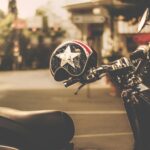Have you ever pulled off your helmet only to find yourself with the dreaded “helmet hair?” You are not alone. Riders everywhere struggle with tangles and frizz, or flat and sweaty roots. With such a large focus on safety, equipment and technique with motorcycling, hair care for motorcycle riders is frequently overlooked.
But here’s the good news: you don’t have to choose between great rides and great hair.
In my first two years of motorcycling, I investigated everything possible to prevent my hair from damage. From pre-ride prep to protective hairstyles, post-ride recovery and top-rated products, I reviewed it all. Whether you are a daily commuter or weekend explorer, proper hair care for motorcycle riders is something that would benefit every rider.
This guide will therefore teach you how to protect and maintain healthy hair as a motorcyclist – all without compromising the thrill of the ride.
Let’s dive in!


Why is Hair Care for Motorcycle Riders Important?
Motorcycle riders often prioritise safety gear like helmets and gloves, but hair care frequently takes a back seat. However, neglecting your hair can lead to issues such as dryness, breakage, scalp irritation, and even hair loss over time.
For example, helmet cleanliness and scalp health is an association that has been formally investigated. A study published in the International Journal of Microbiology found that helmets which were never washed or disinfected showed higher bacterial (86.7%) and fungal (83.3%) growth compared to those that were regularly cleaned.This microbial buildup can lead to scalp infections, inflammation, and hair damage.
For many riders, hair care isn’t just about appearance—it’s about comfort and health. A sweaty, itchy scalp or tangled hair can make rides less enjoyable. By prioritising hair care, you can maintain strong, manageable hair that withstands the rigours of the road, ensuring that your helmet comes off, but your confidence stays on.
Finally, comfort on the bike isn’t just for riders—passengers need to feel good too, and that includes keeping their hair healthy and protected during the ride.

How Motorcycle Riding Affects Your Hair
Motorcycle riding is exhilarating and gives a unique sense of freedom on the open road. But this exciting experience also exposes your hair to a variety of environmental and physical stressors. These factors can quickly add up and wreak havoc on your hair if you’re not careful.
- Friction from helmets: Constant rubbing against your hair can cause breakage, split ends, and thinning over time if not properly managed.
- Sweat and heat: Prolonged sweating under a helmet creates a moist environment that can make your scalp itchy and oily, and may even lead to clogged follicles or scalp irritation.
- Wind and sun exposure: UV rays dry out and fade hair colour, while strong winds cause tangling and strip moisture from strands, leaving hair brittle and fragile.
- Pollution and road debris: Hair is exposed to dirt, dust, and exhaust particles, especially when it’s not fully covered, which can contribute to buildup and damage.
Of course, the type of helmet you use plays a big role in how your hair is affected—especially on long rides. If touring is your style, choosing the best helmet for travel can reduce pressure points and improve overall comfort.

What Hair Products Should Motorcycle Riders Use?
Before diving into specific brands, it’s important to understand the basics. Motorcycle riders need haircare products that can withstand sweat, wind, and helmet friction while keeping hair healthy and hydrated. Choosing the right formulas sets the foundation for damage prevention both during and after the ride.
- Moisturizing shampoos and conditioners: Look for formulas with hydrating ingredients like aloe vera, shea butter, or argan oil to restore moisture and reduce breakage.
- Leave-in conditioners: These provide an added layer of protection against helmet friction and environmental exposure, keeping hair soft and manageable.
- Heat and UV protectant sprays: These sprays help shield your strands from the sun’s rays and the drying effects of wind and heat buildup under your helmet.
- Lightweight styling products: Use non-greasy, residue-free styling creams or serums that won’t clog follicles or create buildup when combined with sweat and helmet wear.
- Clarifying shampoos (used occasionally): These help cleanse away pollutants, product residue, and excess oil without stripping essential natural oils.
Using the right products can make all the difference in maintaining healthy, resilient hair—especially for riders who spend long hours on the road. For more ways to improve your overall riding experience, check out our guide on how to make your motorcycle more comfortable.

Pre-Ride Hair Care for Motorcycle Riders
What you do before you ride sets the foundation for healthy hair.
- Start with clean, dry hair: Riding with wet or damp hair makes it more prone to breakage and fungal growth inside a helmet.
- Use a lightweight leave-in conditioner: Adds a protective barrier without weighing hair down.
- Apply a heat or UV protectant: Shields hair from sun and heat-related damage, especially important for color-treated hair.
- Avoid heavy oils before rides: They can clog your pores when mixed with sweat and grime inside the helmet.
- Dealing with longer hair? Use a detangler spray to minimize friction-induced knots.
By taking a few extra minutes to prep your hair before your ride, you can minimize damage and make post-ride care much easier. Paired with a solid pre-ride routine, wearing a lightweight helmet can help minimise hair stress and keep your scalp feeling fresh and cool.

Best Hairstyles for Riding: Secure, Stylish, and Protective
The right hairstyle can make or break your riding experience—literally.
- Low braid or twin braids: Keeps hair secure and evenly distributes tension.
- Hair tucked into a buff or undergarment: Reduces contact with the helmet’s lining and protects against pollution.
- Twists or a low bun at the nape: Keeps hair out of your face and helmet padding.
- Avoid high ponytails or top knots: These create pressure points and can damage hair or distort helmet fit.
- Use soft, snag-free elastics or scrunchies: Prevent breakage and stress on the roots.
Protective hairstyles are especially useful when you’re on the road for hours—or even days. Whether you’re commuting locally or riding across scenic regions like Italy, you’ll want a style that can hold up mile after mile.

Helmet Liners and Headgear: Your First Line of Defence
A clean helmet is essential—but so is what you wear underneath it.
- Use a moisture-wicking liner or skull cap: Helps absorb sweat, reduce friction, and keep your hair in place.
- Choose breathable fabrics: Bamboo, merino wool, or technical fabrics work better than cotton, which holds moisture.
- Wash or change your liner regularly: Dirty liners can cause buildup and scalp irritation.
- Buffs and silk scarves: Great for longer hair and hot weather riding; they reduce static and breakage.
- Helmet fit still matters: Make sure added headgear doesn’t interfere with your helmet’s safety certification or comfort.
Maintaining a clean, well-fitted helmet creates a healthier environment for your hair and scalp—making a big difference over time.
Pro Tip: If you are using a motorcycle or scooter on a beach holiday, make sure you let your hair fully dry before wearing your helmet. I can tell you from experience that the salt will penetrate and sit inside the lining of your helmet and feel quite nasty. Alternatively, I have also worn a fabric/gauze hair net like hospitality workers/chefs wear. It is very ugly, but no one sees it under the helmet and it prevents the salt and sweat from seeping into the lining quite well.

Post-Ride Hair Care for Motorcycle Riders
Once the ride’s over, give your hair the love it deserves.
- Cleanse your scalp: Use a gentle shampoo to remove sweat, oils, and pollutants. Look for sulfate-free formulas.
- Deep condition weekly: Replenish moisture and prevent breakage. Look for ingredients like argan oil, shea butter, and keratin.
- Use a microfiber towel or air dry: Reduces friction and helps maintain curl patterns or wave definition.
- Scalp care matters: Consider a weekly scalp scrub or lightweight serum to improve scalp health and reduce buildup.
- Avoid heat tools immediately: Let your hair recover naturally before using a blow dryer or straightener.
A consistent post-ride routine is key to refreshing your hair and scalp, preventing long-term damage, and restoring your hair’s natural balance.

Hair Care for Motorcycle Riders with Different Hair Types
Hair care is not one-size-fits-all. Here’s how to tailor your routine.
Straight Hair
- Use light styling products to avoid oil buildup
- Focus on friction prevention with a silk liner or buff
- Dry shampoo can be your best friend post-ride
Curly or Wavy Hair
- Opt for protective braids or twists
- Use curl creams or leave-ins before riding
- Refresh curls post-ride with a water-based spray
Coily or Kinky Hair
- Moisturise well before rides
- Wear silk-lined caps or durags
- Deep condition more frequently to combat dryness
Colour-Treated or Bleached Hair
- UV protectants are a must
- Avoid riding with hair exposed—cover it fully
- Use bond-repairing treatments weekly
No matter your hair type, tailoring your routine to suit your specific texture ensures healthier, more manageable hair—both on and off the bike.

How Accessories Affect Your Hair While Riding
While helmets are the main culprit, many riders don’t realise that everyday accessories worn under the helmet can also contribute significantly to hair damage.
- Hair accessories: Items like hair ties, clips, and headbands can create pressure points and cause friction when worn under a helmet. Tight elastics especially can snag and break strands, while metal clips may cause localized breakage.
- Earrings: Large or dangling earrings can get caught in hair or helmet padding, leading to tangles and accidental pulling that damages hair roots and strands.
- Sunglasses: Wearing sunglasses under your helmet, especially those with thick arms, can press against the hair and scalp, causing friction and even flattening or breaking hair over time.
All these accessories add extra layers of friction and tension, which, combined with helmet wear, increase the risk of hair breakage and scalp discomfort. Minimising or choosing gentle, low-profile accessories can help protect your hair during every ride.
Pro Tip: I have tried all the above – hair clips, ties, earrings and sunglasses. Anything above bobby pins and soft hair elastics will dent your head underneath the snug fit of the helmet. Any earrings larger than small studs will also dent your ears, poke into the side of your jaw, or become dislodged. I can sometimes fit sunglasses in underneath the helmet, but I now just use the build-in sun shield.

Quick Tips for Long Motorcycle Rides or Touring
On the road for days or weeks? Here’s how to simplify your routine:
- Pack travel-sized essentials in leak-proof bags
- Dry shampoo and leave-in conditioner can save you in a pinch
- Bring a wide-tooth comb or detangling brush to prevent knots
- Wash your liner mid-trip if you’re sweating daily
- Rest days = hair recovery days—mask and moisturise when off the bike
Pro Tip: Whenever we go travelling, my husband and I rent a motorcycle or scooter to use as our main mode of transport. Because of this, we only take carry-on luggage that can be strapped down to the bikes. The haircare essentials I always carry are shampoo and conditioner, leave-in conditioner, hair oil, soft elastics, bobby pins and a brush. This works quite well for me as I have a short, wavy bob. You might need more as per your hair routine.

FAQ: Hair Care for Motorcycle Riders
Q. How do I stop my hair from getting greasy under my helmet?
Start with clean, dry hair, avoid applying oils beforehand, and use a lightweight, non-comedogenic leave-in. Excess oil can come from sweating during rides or using heavy products before putting on your helmet. Consider a moisture-wicking skull cap or liner to absorb sweat. Dry shampoo after your ride can also help refresh your roots.
Q. Is it better to ride with my hair up or down?
Always secure your hair to prevent breakage and tangling. Styles like low braids, twists, or a low bun work best under a helmet. Loose hair rubs against the helmet liner and catches wind, leading to split ends and knots—especially on longer rides.
Q. What’s the best way to prevent helmet hair?
Helmet hair is caused by friction, heat, and sweat. To reduce it, wear a silk or moisture-wicking liner, braid your hair, and make sure your helmet fits properly. Post-ride, fluff your roots with a wide-tooth comb or use a volumising spray to revive flat areas.
Q. How can I protect colour-treated hair while riding?
Always apply a UV-protectant spray before rides, and tuck your hair into a buff, scarf, or under layer. Colour-treated hair is especially vulnerable to sun and wind exposure. Avoid exposing your hair directly to the elements, and deep condition weekly to keep it hydrated and vibrant.
Q. Do short-haired riders need to worry about hair care?
Absolutely. Even short hair can suffer from scalp buildup, friction, and UV damage. Focus on keeping your scalp clean, using scalp-friendly products, and protecting your head with a breathable liner or buff. A healthy scalp means healthier hair—no matter the length.

Final Thoughts
Motorcycling is more than just a hobby—it’s a lifestyle. Just like you invest in safety gear, proper tools, and quality riding equipment, your hair deserves the same attention.
By prioritising hair care for motorcycle riders, you’re not just preserving your looks—you’re preventing long-term damage, discomfort and optimising scalp health. Whether you have long, short, curly, or colour-treated hair, there’s a routine and setup that will work for you.
So go ahead—ride the wind, conquer the open road, and look great doing it. Your helmet might come off, but your confidence doesn’t have to.
What have been your hair care saviours as a motorcycle rider? Let me know in the comments!





